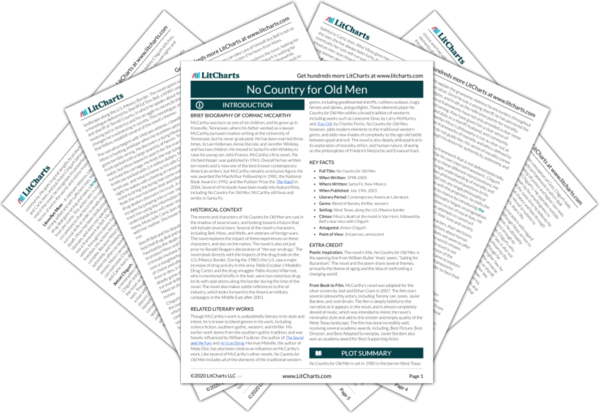Welcome to the LitCharts study guide on Cormac McCarthy's No Country for Old Men. Created by the original team behind SparkNotes, LitCharts are the world's best literature guides.
No Country for Old Men: Introduction
No Country for Old Men: Plot Summary
No Country for Old Men: Detailed Summary & Analysis
No Country for Old Men: Themes
No Country for Old Men: Quotes
No Country for Old Men: Characters
No Country for Old Men: Symbols
No Country for Old Men: Theme Wheel
Brief Biography of Cormac McCarthy

Historical Context of No Country for Old Men
Other Books Related to No Country for Old Men
- Full Title: No Country for Old Men
- When Written: 1998-2005
- Where Written: Santa Fe, New Mexico
- When Published: July 19th, 2005
- Literary Period: Contemporary American Literature
- Genre: Blend of literary, thriller, western
- Setting: West Texas, along the U.S./Mexico border
- Climax: Moss’s death at the motel in Van Horn, followed by Bell’s near miss with Chigurh
- Antagonist: Anton Chigurh
- Point of View: 3rd person, omniscient
Extra Credit for No Country for Old Men
Poetic Inspiration. The novel’s title, No Country for Old Men, is the opening line from William Butler Yeats’ poem, “Sailing for Byzantium.” The novel and the poem share several themes, primarily the theme of aging and the idea of confronting a changing world.
From Book to Film. McCarthy’s novel was adapted for the silver screen by Joel and Ethan Coen in 2007. The film stars several noteworthy actors, including Tommy Lee Jones, Javier Bardem, and Josh Brolin. The film is deeply faithful to the narrative as it appears in the novel, and is almost completely devoid of music, which was intended to mimic the novel’s minimalist style and add to the sinister and empty quality of the West Texas landscape. The film has done incredibly well, receiving several academy awards, including, Best Picture, Best Director, and Best Adapted Screenplay. Javier Bardem also won an academy award for Best Supporting Actor.







